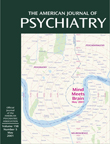Acute Visual Loss After Thioridazine Overdose
To the Editor: Progressive chorioretinopathy with gradual visual loss after thioridazine treatment is well documented (1–4). The reported cases have been attributed to the toxic effects of thioridazine in damaging retinal structures. We report a case of acute bilateral visual loss subsequent to an overdose of thioridazine.
Mr. A, a 29-year-old man, was admitted to the emergency department while unconscious. He had ingested in excess of 1500 mg of thioridazine with a moderate amount of alcohol. Two years before this hospitalization, he had been maintained with thioridazine, 100 mg/day, to treat a psychiatric illness. On admission his blood pressure was 90/50 mm Hg, and his pulse was 110 bpm. The next morning, before further assessment, he left the hospital. He visited his general practitioner 11 days later complaining of decreased vision since the overdose and was referred for ophthalmological assessment.
His visual acuity was 3/60 in the right eye and 2/60 in the left eye. His pupils were dilated, and he had a sluggish, minimal reaction to light. A fundoscopy revealed poorly perfused retinal arteries with diffuse retinal edema and bilateral cherry-red maculae that were consistent with central retinal artery nonperfusion. The results of a Goldmann field test showed that his visual field was constricted to a central island. These findings were unchanged at a review conducted 1 week later. Fundus fluorescein angiography showed arterial and venous nonperfusion with poor choroidal perfusion. Subsequently, Mr. A failed to return for follow-up and electrodiagnostic tests.
Many side effects of thioridazine treatment have been noted, including, specific to the visual system, pigmentary retinopathy accompanied by subacute and chronic vision loss (5). Typically, the symptoms of toxicity are blurred vision and reduced night vision 3–8 weeks after the beginning of thioridazine treatment, usually at doses greater than 800 mg/day (1–3), although symptoms have been reportedly found at a lower dose (4). Another side effect is the induction of hypotension.
Our patient had an acute bilateral loss of vision that had not been previously reported. This is presumed to be due to central retinal artery nonperfusion secondary to a thioridazine-induced acute hypotensive episode. Retinal artery occlusion after episodes of hypotension has previously been reported during spinal surgery after prolonged hypotensive anesthesia and with systolic blood pressures of 90 mm Hg or less (6). No preoperative vascular risk factors were identified.
To our knowledge, this is the first reported case of acute visual loss after ingestion of thioridazine. It highlights the potential danger of an overdose of thioridazine and should be considered when prescribing this drug in large quantities.
1. Davidorf FH: Thioridazine pigmentary retinopathy. Arch Ophthalmol 1973; 90:251–255Crossref, Medline, Google Scholar
2. Hagopian V, Stratton DB, Busiek RD: Five cases of pigmentary retinopathy associated with thioridazine administration. Am J Psychiatry 1966; 123:97–100Link, Google Scholar
3. Shah GK, Auerbach DB, Augsberger JJ, Savino PJ: Acute thioridazine retinopathy. Arch Ophthalmol 1998; 16:826–827Crossref, Google Scholar
4. Tekell JL, Silva JA, Maas JA, Bowden CL, Starck T: Thioridazine-induced retinopathy (letter). Am J Psychiatry 1996; 153:1234–1235Google Scholar
5. British National Formulary: Number 37. London, Pharmaceutical Press, 1999Google Scholar
6. Myers MA, Hamilton SR, Bogosian AJ, Smith CH, Wagner TA: Visual loss as a complication of spine surgery. Spine 1997; 22:1325–1329Google Scholar



